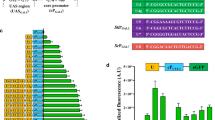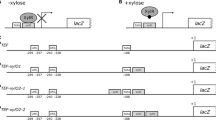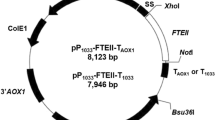Abstract
The signal sequences of the MFα1 prepro α-factor gene are frequently used to direct secretion of heterologous proteins fromSaccharomyces cerevisiae. They are often employed together with the MFα1 promoter in secretion vectors, such that this promoter directs the transcription of many heterologous gene cassettes in yeast. Most of the existing literature indicates that the MFα1 promoter is constitutive in MATα cells, although some data suggests that it may be more active in respiratory or late logarithmic fermentative cultures. To identify whether there is a growth rate or medium control over MFα1 promoter activity a strain was constructed with an integrated MFα1 promoter β-galactosidase (lacZ) reporter gene fusion. Intracellular β-galactosidase of this strain during batch culture on glucose, raffinose and acetate showed that MFα1 promoter activity was higher during respiratory growth on acetate as compared to more rapid fermentative growth on glucose or raffinose a result that might indicate this activity being inversely related to growth rate. Chemostat culture confirmed that growth rate does indeed influence MFα1 promoter activity in glucose-grown cells, the activity of this promoter increasing 2- to 2.5-fold as dilution (growth) rates were reduced from maximal values to 0.2 h−1, but then decreasing with the further decreases in dilution rate needed for fully respiratory growth. Thus a promoter generally thought to be constitutive in MATα cells is nevertheless subject to a complex growth rate control.
Similar content being viewed by others
References
Achstetter T (1989) Regulation of α-factor production inSaccharomyces cerevisiae: α-pheromone-induced expression of the MFα1 and STE13 genes. Mol Cell Biol 9:4507–4514
Bennetzen JL, Hall BD (1982) Primary structure of theSaccharomyces cerevisiae gene for alcohol dehydrogenase 1. J Biol Chem 257:3018–3025
Beretta I, Sanglard D, Kappeli O, Fiechter A (1991) Optimisation ofCandida tropicalis cytochrome P450alk gene expression inSaccharomyces cerevisiae. Appl Microbiol Biotechnol 36:48–60
Bitter GA (1987) Controlled expression and purification of human immune interferon from high cell density fermentations ofSaccharomyces cerevisiae. Biotechnol Bioeng 29:1113–1121
Bitter GA, Egan KM, Koski RA, Jones MO, Elliott SG, Giffin JC (1987) Expression and secretion vectors for yeast. Methods Enzymol 153:516–544
Boeke JD, Lacroute F, Fink GR (1984) A positive selection for mutants lacking orotidine-5-phosphate decarboxylase activity in yeast: 5-fluoro-orotic acid resistance. Mol Gen Genet 197:345–346
Brake AJ, Merryweather JP, Coit DG, Heberlain VA, Maziarz FR, Mullenbach GT, Urdea MS, Valenzuela P, Barr PJ (1984) α-Factor-directed synthesis and secretion of mature foreign proteins inSaccharomyces cerevisiae. Proc Natl Acad Sci USA 81:4642–4646
Chen Y, Kirk N, Piper PW (1993) Effects of medium composition on MFα1 promoter-directed secretion of a small protease inhibitor inSaccharomyces cerevisiae batch fermentation. Biotechnol Lett 15:223–228
Das RC, Shultz JL (1987) Secretion of heterologous proteins fromSaccharomyces cerevisiae. Biotechnol Prog 3:43–48
De Nobel JG, Barnett JA (1991) Passage of molecules through yeast cell walls: a brief essay-review. Yeast 7:313–323
Ernst JF (1986) Improved secretion of heterologous proteins bySaccharomyces cerevisiae: effects of promoter substitution in alpha-factor fusions. DNA 5:483–491
Flessel MC, Brake AJ, Thorner J (1989) The MFα1 gene ofSaccharomyces cerevisiae: genetic mapping and mutational analysis of promoter elements. Genetics 121:223–236
Fieshko JC, Egan KM, Ritch T, Koski RA, Jones M, Bitter GA (1987) Controlled expression and purification of human immune interferon from high cell density fermentations ofSaccharomyces cerevisiae. Biotechnol Bioeng 29:1113–1121
Geitz RD, Sugino A (1988) New yeast-Escherichia coli shuttle vectors constructed within vitro mutagenised yeast genes lacking six-base pair restriction sites. Gene 74:527–534
Geitz D, StJean A, Woods RA, Scheistl RH (1992) Improved method for high efficiency transformation of intact yeast cells. Nucleic Acids Res 20:1425
Goodey AR, Doel S, Piggott JR, Watson MEE, Carter BLA (1987) Expression and secretion of foreign polypeptides by yeast. In: Berry DR, Russell I, Stewart GG (eds) Yeast biotechnology. Allen and Unwin, London, pp 401–429
Gu MB, Park MH, Kim D-I (1991) Growth rate control in fed-batch cultures ofSaccharomyces cerevisiae producing hepatitis B surface antigen (HBsAg). Appl Microbiol Biotechnol 35:46–50.
Herskovitz I (1989) A regulatory hierarchy for cell specialisation in yeast. Nature 342:749–757
Kobayashi H, Nakazawa N, Harashima S, Oshima Y (1990) A system for temperature-controlled expression of a foreign gene with dual mode inSaccharomyces cerevisiae. J Ferment Bioeng 69:322–327
Kramer RA, DeChiara TM, Schaber MD, Hillilker S (1984) Regulated expression of a human interferon gene in yeast: control by phosphate concentration or temperature. Proc Natl Acad Sci USA 81:4642–4646
Kurjan J, Herskowitz I (1982) Structure of a yeast pheromone gene (MFα1): a putative α-factor precursor contains four tandem copies of mature α-factor. Cell 30:933–943
Miller JH (1972) Experiments in molecular genetics. Cold Spring Harbor Laboratory, Cold Spring Harbor, NY
Penttila ME, Andre L, Lehtovaara P, Bailey M, Teeri TT, Knowles JKC (1988) Efficient secretion of two fungal cellobiohydrolases bySaccharomyces cerevisiae. Gene 63:103–112
Postma E, Verduyn C, Scheffers WA, Dijken JP van (1989) Enzymic analysis of the Crabtree effect in glucose-limited chemostat cultures ofSaccharomyces cerevisiae. Appl Environ Microbiol 55:468–477
Rieger M, Kappeli O, Fiechter A (1983) The role of limited respiration in the incomplete oxidation of glucose bySaccharomyces cerevisiae. J Gen Microbiol 129:653–661
Romanos MA, Scorer CA, Clare JJ (1992) Foreign gene expression in yeast: a review. Yeast 8:423–488
Rothstein SJ, Lahners KN, Lazarus CM, Baulcombe DC, Gatenby AA (1987) Synthesis and secretion of wheat alpha amylase inSaccharomyces cerevisiae. Gene 55:353–356
Scheckman R, Novick P (1982) The secretory process and yeast cell surface assembly In: Strathern JN, Jones EW, Broach JR (eds) The molecular biology of the yeastSaccharomyces. Cold Spring Harbor Laboratory Press, Cold Spring Harbor, N.Y., pp 361–393
Schultz LD, Tanner J, Hofmann KJ, Emini EA, Condra JH, Jones RE, Kieff E, Ellis RW (1987) Expression and secretion in yeast of a 400-kDa envelope glycoprotein derived from Epstein-Barr virus. Gene 54:113–123
Sherman F, Fink GR, Hicks JB (1983) Methods in yeast genetics. Cold Spring Harbor Laboratory, Cold Spring Harbor, N.Y.
Singh A, Chen EY, Lugovoy JM, Chang CN, Hitzeman RA, Seeburg PH (1983)Saccharomyces cerevisiae contains two discrete genes coding for the α-factor pheromone. Nucleic Acids Res 11:4049–4063
Southgate VJ, Steyn AJC, Pretorius IS, Van Vuuren HJJ (1993) Expression and secretion ofBacillus amyloliquefaciens α-amylase by using the yeast pheromone α-factor promoter and leader sequence inSaccharomyces cerevisiae. Appl Environ Microbiol 59:1253–1258
Von Meyenburg HK (1969) Energetics of the budding cycle ofSaccharomyces cerevisiae during glucose limited aerobic growth. Arch Mikrobiol 66:289–292
Wood CR, Boss MA, Kenten JH, Calvert JE, Roberts NA, Emtage JS (1985) The synthesis andin vivo assembly of functional antibodies in yeast. Nature 314:446–449
Zurbriggen B, Kuhne AB, Kallio P, Kappelli O, Fiechter A (1989) Controlled expression of heterologous cytochrome P450e cDNA inSaccharomyces cerevisiae. II Development of cultivation process for heterologous cytochrome P450e production. J Biotechnol 9:273–286
Author information
Authors and Affiliations
Rights and permissions
About this article
Cite this article
Kirk, N., Piper, P.W. Growth rate influences MFα1 promoter activity in MATαSaccharomyces cerevisiae . Appl Microbiol Biotechnol 42, 340–345 (1994). https://doi.org/10.1007/BF00902739
Received:
Revised:
Accepted:
Issue Date:
DOI: https://doi.org/10.1007/BF00902739




